Kinetic's 1/48 scale
F-16A MLU NATO Viper
&
F-16C Block 25/42 USAF
by Mick Evans
|
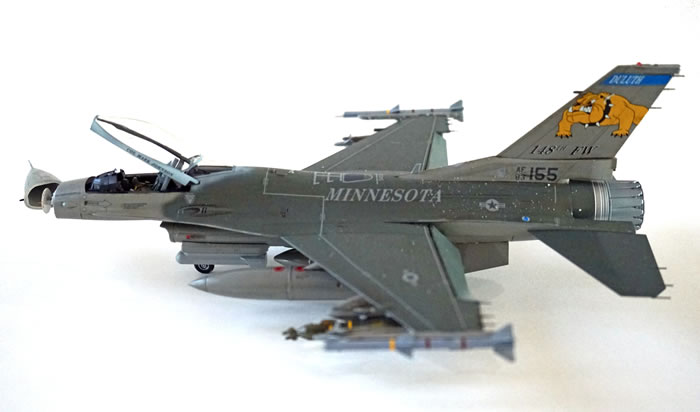
|
F-16C Block 25/42 USAF |

Kinetic first released their F-16 in 2008. This first edition had some minor shape issues with the nose but the kit was a pleasure to build and was nicely engineered and fitted together well.
Kinetic re-released the kit quickly with corrections to the moulds to correct the nose shape issues. This re-release then formed the basis for a whole range of F-16s from Kinetic covering almost every version and production “Block”.
Now, 14 years on, Kinetic has decided to do a complete new re tool of the original F-16 kit. I almost wrote ‘almost complete retool” as it looks like some parts of the mould have been recycled onto new sprues, such as fuel tanks, weapons etc but I cannot be sure as the sprue layout is totally different from the earlier kits, but after having built approximately 10 Kinetic F-16s I am familiar with most of the parts in the earlier kits and some of these parts look identical.
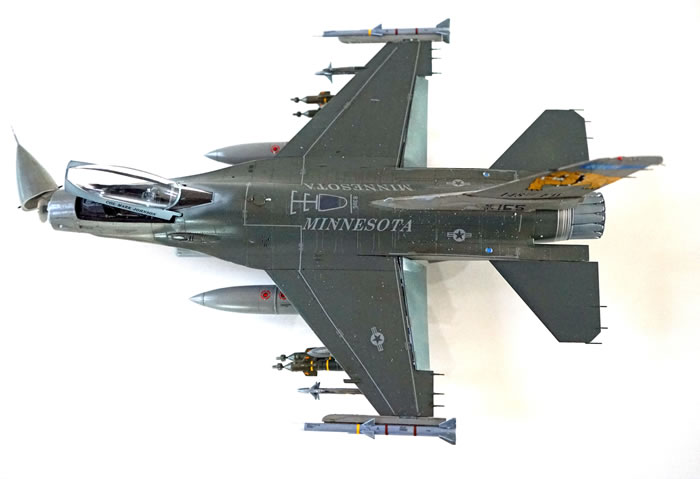
I was interested to see what was different in the new kits from the original 2008 release. Both the new F-16A and F-16C kits are identical as the kits contain the same sprues with all the parts to build either an F-16A or F-16C. What has changed? Well the fuselage is broken down differently with a complete lower fuselage without the lower wings attached, (the earlier kit had the lower wings attached causing some minor fit issues). The upper fuselage has the upper wings attached but now has the forward fuselage attached and a fuselage break just behind the wings. Two separate upper rear fuselages are supplied for differing versions.
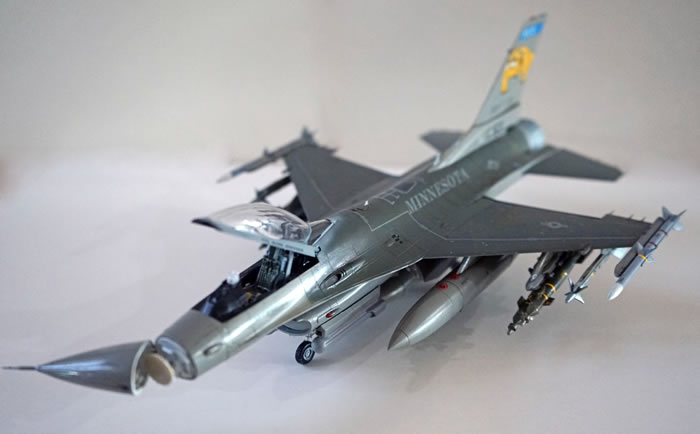
Upon assembly of these parts no seams are visible and no filler is required at all. The join line of the upper rear fuselage to the forward rear fuselage is so well engineered and moulded along a panel line it becomes an invisible join and just looks like a moulded panel line. The lower wing insert is similar with all joins on panel lines. The only join line that I had to do any sanding and filling on was the radome halves joint. The rear fuselage upper and lower joint is along the upper edge and almost disappears when glued, I did have to slightly sand the F-16A joint but this my fault. All the other joints fall on panel lines and are so well engineered no other sanding or filler is required.
The level of detail in the cockpit and wheel wells is excellent and while the ejection seats are good, I chose to replace them with aftermarket resin seats as I do for almost every kit I build. The option to display the radome open is provided and a fairly detailed radar is also provided.
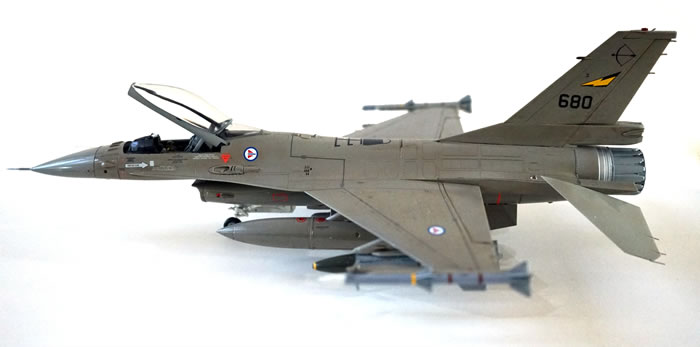
The horizontal stabilisers are mounted into poly caps which allows them to be permanently moveable while the flaps can be positioned raised or lowered.
The detail for the Pratt and Witney F-100 engine exhaust nozzle is very good but it does look a bit thick and chunky. Both the early lightweight and the later heavyweight landing gear and wheels is also provided as are two versions of the radar.
The canopy can be positioned open or closed. In the open position tabs are fitted on the canopy allowing for a positive locate in the raised position.
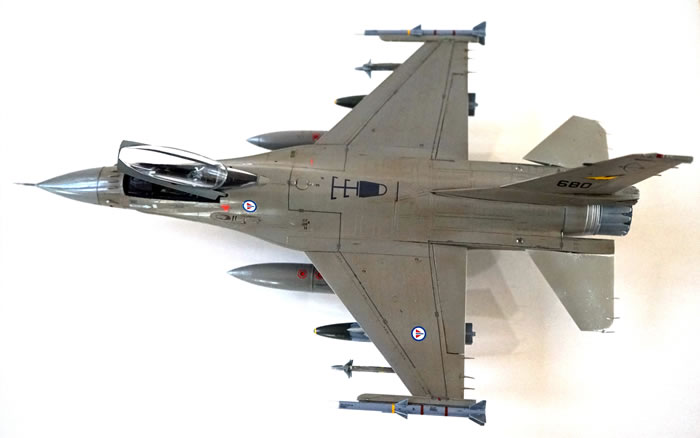
At this point my only criticism of the kits is that with the F-16C Block 25/42 is that you actually cannot build a Block 42 from the kit. Kinetic to not supply the ECS exhaust vent that is very prominent on the right hand side forward fuselage just below the cockpit, and the fuselage does not have the many reinforcing/stiffening plates added to the fuselage and fin over the years. The ECS vent can be easily scratch-built and the reinforcement plates are available in vinyl from some after-market companies, but why advertise it as a Block 42 that can’t be built without aftermarket parts.
Also the instruction seat is typical of Kinetic and one thing Kinetic really needs to do is improve on the quality of the instructions. There are some errors and it looks like some areas of the instructions were cut and pasted from the original 2008 version. For example the main undercarriage locking braces does not locate to the bay the way they are portrayed in the instructions. Arrows for removing some detail to not actually point to the item to be removed and the instructions are not perfectly clear on which panel lines need to be filled.
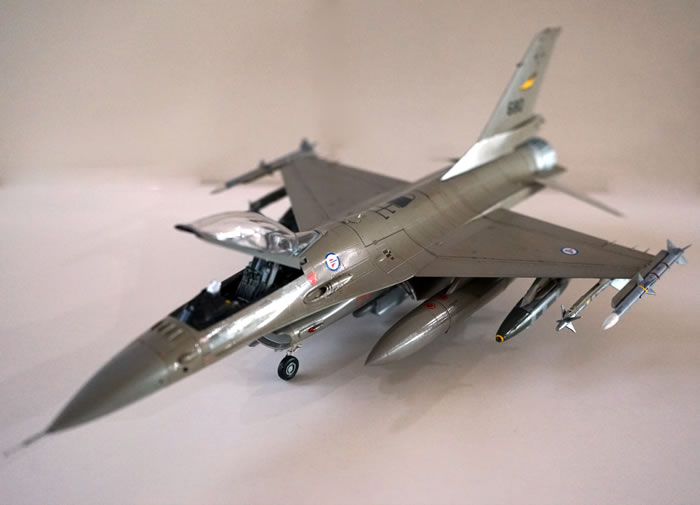
The kit provides the following range of external stores:
-
2 x AIM-9M Sidewinder Air to Air Missile
-
2 x AIM-9X Sidewinder Air to Air Missiles
-
2 x AIM-120B/C AMRAAM Air to Air Missiles
-
2 x AGM-88 Harm Missiles
-
2 x GBU-12 Paveway II
-
2 x GBU-24 Paveway III
-
2 x GBU-31 JDAM
-
ALQ-184 ECM Pod
-
AAQ-13 Lantirn Pod
-
AAQ-14 Lantirn Pod
-
AAQ-28 Lightning Pod
-
Sniper XR Pod
-
300 gallon centre line tank
-
370 gallon wing tanks
For the F-16 MLU Kit the decal sheets provide markings for five aircraft:
- F-16A MLU, FA-86, Belgium Air Force, Air Policing Baltic States, Amari Air Base, Estonia in 2016.
- F-16A MLU, J-515, Netherlands Air Force EEAW/EPAF, Kabul Airport in 2006.
- F-16A MLU, 680, Norwegian Air Force 338 Skv, Kabul Airport,in 2006.
- F-16A MLU, E603, Danish Air Force Esk 730, Aalborg AB, Denmark in 2016
- F-16A MLU, 15115, Portuguese Air Force Escuadra 201, Monte Real AB, Portugal
For the F-16C Block 25/42 Kit the decal sheets provide markings for three aircraft:
-
F-16C Block 25, 83-147, of the 147 Fighter Wing, Texas Air National Guard in 2007.
-
F-16C Block 25, 83-155, of the 148 Fighter Wing, Minnesota Air National Guard in 2008.
-
F-16C Block 42, 90-702, of the 112 Fighter Wing in 2017, Ohio Air National Guard in 2020.
After having built 10 F-16 kits from Hasegawa, Tamiya and all eras and versions of the Kinetic F-16s I find there is not much difference between the Tamiya and the latest Kinetic release. It is almost impossible to find the join lines on the Kinetic kits if assembled patiently. I used no sanding or filler on the kits and I am very pleased with the results. Lining all my F-16s up it is difficult to tell the manufacturer of each kit with Hasegawa being the easiest as it’s the oldest and a much different assembly process. The huge array of weapons load supplied by Kinetic does make it good value for money.
Model and Text Copyright ©
2023 by Mick Evans
Page Created 29 June, 2023
Last Updated
29 June, 2023
Back to
HyperScale Main Page

|
Home
| What's New |
Features |
Gallery |
Reviews |
Reference |
Forum |
Search